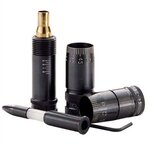- Messages
- 63
- Reactions
- 62
Hey guys, having an issue with a new AR-15 I just put together and wanted to run it by the community.
Mods - feel free to move this to the reloading sub if you think that's a better place for it.
The gun-
Anderson Lower/Aero Upper
Ballistic Advantage 18" .223 Wylde 1/8 Fluted SPR Barrel, rifle gas
PSA Premium BCG (HPT/MPI)
A2 stock/rifle-length receiver extension and rifle-size buffer
Factory .223 ammunition, in this case Wolf Gold .223, chambers and runs fine.
My .223 hand loads are giving me an issue. They are mixed headstamp brass, 24gr of H335 under a 55gr Hornady FMJ at 2.200" and a S&B SR primer. This load runs just fine as a light plinking load in all my other rifles with 5.56 chambers and my mini-14 (.223).
I had several hand loads that either refused to chamber or chambered with resistance in the rifle in question. After shooting I noticed an abnormal/excessive amount of brass buildup on the bolt face, and some of the spent brass had rings around the shoulder. Several cartridges in particular wouldn't chamber at all - I set these aside and measured them when I came home from the range. I observed that the top of the shoulder of the case, measured from the case head, was about .01" longer than the spec listed in my Lyman 49th edition manual. The rounds in question chamber and cycle freely by hand in my 5.56 chambered rifle.
I observed that this particular BCG from PSA has a thicker than usual phosphate coating.
My theory is that, for one, I did not adequately set the shoulders back on these cartridges when reloading them. This is being compounded by the tighter chamber in this particular gun, and the thicker phosphate coating on the bolt slightly reducing overall headspace.
My plan of action is to:
1. Allocate my stock of these handloads to the rifles that chamber it normally, and stop shooting them in this gun
2. Purchase a .223 case gauge and check my brass that will go into this gun going forward
Is this the right approach? Is there anything I'm missing here? Am I going to blow my hands off? Is shrimp the worst top ramen flavor?
Mods - feel free to move this to the reloading sub if you think that's a better place for it.
The gun-
Anderson Lower/Aero Upper
Ballistic Advantage 18" .223 Wylde 1/8 Fluted SPR Barrel, rifle gas
PSA Premium BCG (HPT/MPI)
A2 stock/rifle-length receiver extension and rifle-size buffer
Factory .223 ammunition, in this case Wolf Gold .223, chambers and runs fine.
My .223 hand loads are giving me an issue. They are mixed headstamp brass, 24gr of H335 under a 55gr Hornady FMJ at 2.200" and a S&B SR primer. This load runs just fine as a light plinking load in all my other rifles with 5.56 chambers and my mini-14 (.223).
I had several hand loads that either refused to chamber or chambered with resistance in the rifle in question. After shooting I noticed an abnormal/excessive amount of brass buildup on the bolt face, and some of the spent brass had rings around the shoulder. Several cartridges in particular wouldn't chamber at all - I set these aside and measured them when I came home from the range. I observed that the top of the shoulder of the case, measured from the case head, was about .01" longer than the spec listed in my Lyman 49th edition manual. The rounds in question chamber and cycle freely by hand in my 5.56 chambered rifle.
I observed that this particular BCG from PSA has a thicker than usual phosphate coating.
My theory is that, for one, I did not adequately set the shoulders back on these cartridges when reloading them. This is being compounded by the tighter chamber in this particular gun, and the thicker phosphate coating on the bolt slightly reducing overall headspace.
My plan of action is to:
1. Allocate my stock of these handloads to the rifles that chamber it normally, and stop shooting them in this gun
2. Purchase a .223 case gauge and check my brass that will go into this gun going forward
Is this the right approach? Is there anything I'm missing here? Am I going to blow my hands off? Is shrimp the worst top ramen flavor?













